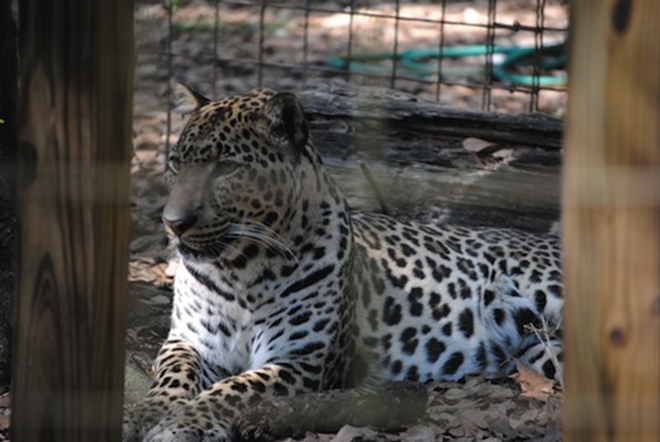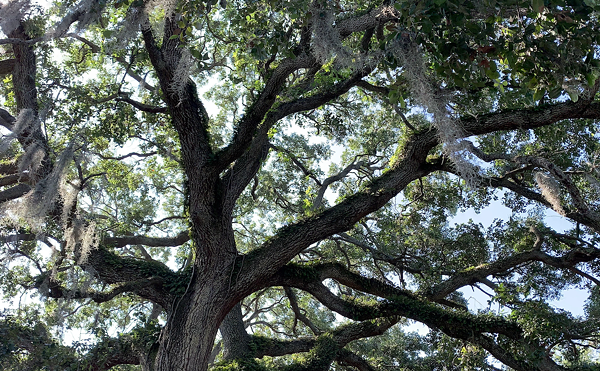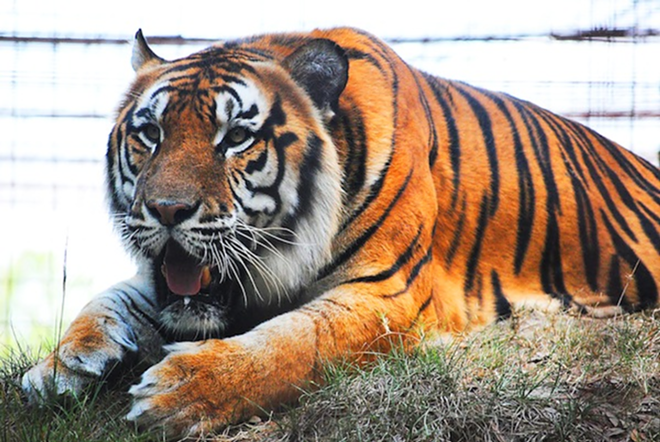
Big Cat Rescue, the Tampa sanctuary for lions, tigers and other exotic felines, has a simple mission: to one day go out of business.
“Our goal is not to have to rescue animals,” says BCR’s Jeff Kremer. “The goal is to keep the animals out of entertainment and out of the exotic pet trade.”
House Resolution 4122, or The Big Cats and Public Safety Protection Act, may help Kremer and BCR realize that dream. There’s support for the measure from Senator John Kerry and FL U.S. Representatives Kathy Castor and Gus Bilirakis, as well as from movie stars like Leonardo DiCaprio. The bill, if passed, would protect exotic cats from the risks of private ownership, illustrated by the slaughter last year of 49 animals in Zanesville, Ohio.
But there’s another camp in the debate. Private breeders worry that the new law would not only pose a threat to their pocketbooks, but to the future of the 39 species of exotic cats. The cat fight has begun.
More than 100 exotic cats live in Big Cat Rescue’s 55-acre compound in Citrus Park, which has provided sanctuary to hundreds of animals since opening 20 years ago.
Reno, a golden leopard, is a retiree from the circus. Nikita the lioness was found during a drug bust in Tennessee, chained to the wall of a crack house. A tiger named Arthur, with brother Andre and sister Amanda, was brought to BCR after his previous home, Wild Animal Orphanage in San Antonio, Texas, closed in 2010.
Then there’s Sasha. A beautiful lioness, she lived the first part of her life chained to a concrete slab in Gambler, Ohio at the International Siberian Tiger Foundation — aka the backyard of a woman named Diana McCourt. She’d had Sasha declawed and defanged to make her easier to manage when folks came to take her picture. When Sasha was finally rescued, her leather collar had grown into the skin of her neck.
Sasha is one of three BCR residents to have been stripped of their natural defenses. Kremer encourages photographers to remove their equipment from tripods when they take her photo; while the exact history is unknown, she and some of the other felines at BCR have developed a fear of anything remotely club-like.
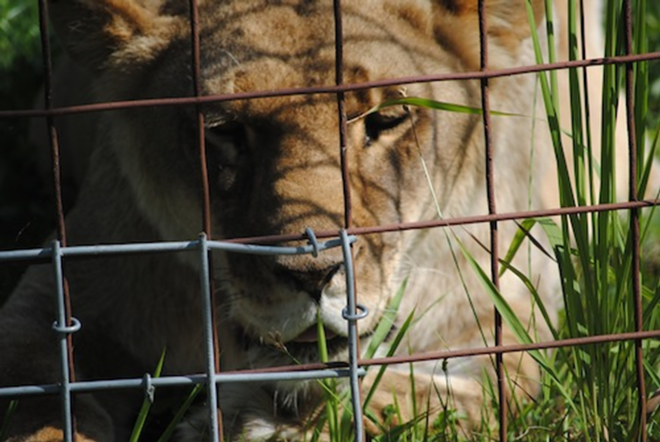
Kremer, who is director of donor appreciation for the non-profit, feels that the biggest threat to captive exotic cats in Florida and across the country is what he calls “pay-to-play” — attractions that exploit animals for entertainment.
“Right now you can go 30 minutes from [Big Cat Rescue] and you can swim with tiger cubs, for $200, in a pool,” Kremer says. “And the media loves it because it’s great eye candy.”
Media General has run multiple stories on the attraction, Dade City’s Wild Things, including one in August, 2011, and two this year on News Channel 8 and TBO.com.
“I think what’s empowering is that all these issues facing these cats are solvable,” Kremer says. “I don’t have to do anything to solve the problems; I have to just not do some things. I have to not go to the circus or not go to the local place where they’re charging $200 to swim with tiger cubs.”

Aligned with BCR in the fight against private ownership and display are organizations like the Humane Society of the United States, the International Fund for Animal Welfare (IFAW), World Wildlife Fund and Born Free USA. Legislative supporters include U.S. Rep. Gus Bilirakis of Tarpon Springs.
“The education Big Cat Rescue provides to adults and kids alike is both informative and interesting, and it is a true treasure for Tampa Bay,” Bilirakis said. “Unfortunately, it is also a necessary role, as there are many people out there who do not treat their animals humanely or in a manner that is safe for others.”
The disaster in Zanesville, Ohio was a case in point. On Oct. 18, 2011, Terry Thompson, the owner of more than 50 exotic animals — among them lions, tigers, bears, leopards, wolves and various primates — released them from their cages before committing suicide. In the ensuing chaos, officials were forced to kill 18 Bengal tigers, 17 lions, six black bears, three cougars, two grizzly bears, two wolves and a baboon.
“It’s like Noah’s Ark wrecking right here in Zanesville, Ohio,” celebrity animal man Jack Hanna said at a press conference the next morning.
Hanna is also director emeritus of the Columbus Zoo, where six surviving animals — three leopards, two primates and a bear — were housed in the wake of the Zanesville massacre. Five of the animals were recently returned to Thompson’s widow, Marian; the zoo had to euthanize one of the leopards.
The Zanesville incident brought increased attention to big cat ownership and led to support for H.R. 4122, drawing comment from celebrity animal rights activists like DiCaprio.
“Tigers, lions and cougars are kept as pets in the U.S. in alarming numbers,” said the actor via his Facebook page, “often leading to mistreatment and cruelty towards the animals themselves, but also diminishing big cat conservation around the world. Let’s prevent another Zanesville, Ohio tragic incident from happening again and take action to ban private ownership of big cats in the US.”
Leo’s post featured a link to the IFAW website, where users could send an email to their local congressperson voicing their support for H.R. 4122.
Sen. John Kerry introduced the companion bill, Senate 3547, on Sept. 13; it has been assigned to the Senate Committee on Environment and Public Works.
“This bill will ensure that these endangered creatures are kept in secure, professional facilities like wildlife sanctuaries,” Kerry said, “rather than in small cages in someone’s backyard or apartment building.”
Kremer says that the issue comes down to one common denominator: in American society, these cats are considered just another thing to be owned. Seemingly lost in the battle over private ownership is the public safety concern posed when a wild animal is kept in captivity in a populated area.
In May, a cougar escaped its backyard enclosure in Hernando County, as reported by Tampa Bay’s CBS affiliate, WTSP-Channel 10. While out, Charlie, the mountain lion, killed a neighbor’s pet beagle. Mickey Milano, owner of the dog, wonders what might happen to her granddaughter if this was the fate of her dog.
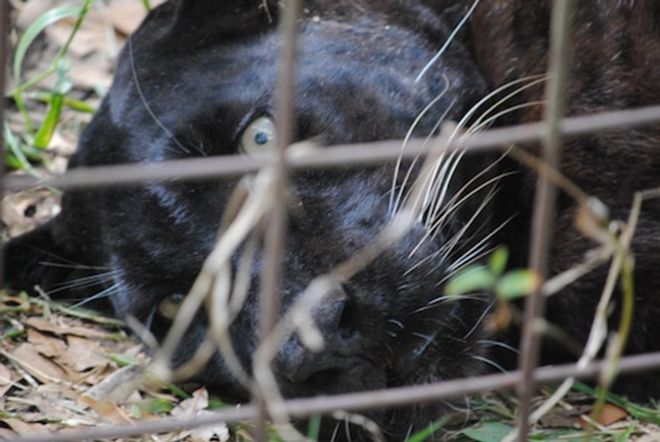
“This black leopard, Sabre, in front of us, that’s not property,” Kremer says, referring to a cat in residence at BCR. “That’s a living, sentient being that should be afforded protection and a certain standard level of care. And it’s a dangerous animal; it’s a carnivore. Leopards can lift two to three times their body weight into trees… That leopard could lift two of me, so why do we consider it, in our society, acceptable to keep something like that in somebody’s house or backyard as a pet?”

Big Cat Rescue is not without its detractors. A 2011 Bay News 9 story called into question the origin of many of the cats they claim to have rescued. Scour the Web enough and you’ll find blogs dedicated to anti-BCR sentiment, calling it a “scam-tuary.”
Opponents use Big Cat Rescue founder Carole Baskin’s beginnings as an exotic cat breeder to fan the flames. The facility’s own website describes its “evolution” from rescuing bobcats by buying them from fur farms to a sanctuary that preaches against buying, selling, trading or breeding.
Lynn Culver, Arkansas-based executive director of the Feline Conservation Federation (FCF), is philosophically opposed both to BCR and to the proposed legislation, which she calls a “manage-to-extinction plan.” She regards Baskin as “the face of ‘No one should have cats.’”
“I really don’t respect her as a person,” she says of Baskin. Camp BCR returns the compliment. “Lynn Culver breeds and sells exotic cats as pets and sees Carole Baskin as the leading threat to her continued business in that trade.”
Reflecting on Zanesville, Culver points out that she and other FCF members were concerned for the welfare of the animals and contacted Ohio sanctuaries within three weeks of Thompson’s incarceration on federal weapons charges, nearly a full year before the calamitous events unfolded. She says the people taking care of the property threatened trespassing charges against sanctuary workers attempting to feed the animals.
“Needless to say he came out of [a year of incarceration] more deranged than he went in. And it wasn’t that the animals were dangerous, it was that the man was dangerous,” Culver said of Terry Thompson.
“Unfortunately, there’s just a trend. Every time there’s a bad owner, who illustrates that there needs to be regulation, there needs to be rules, it doesn’t seem to result in that. It seems to result in taking everybody’s freedoms away,” Culver says.
Her beef with the potential law is that it calls for prohibition instead of regulation and that the Association of Zoos and Aquariums has a monopoly on the breeding exemptions. Culver calls the AZA “a communistic dictatorship” in which member zoos give up individual rights and freedoms, standing to lose perhaps their best stock to a larger zoo. Culver says many smaller zoos would not choose to be AZA members because the exorbitant dues are not worth the risk of having a rare animal poached by Big Brother. Creative Loafing’s requests for comment from AZA were not returned.
“Who is sponsoring this bill?” Culver asks rhetorically. “AZA is not the special interest group. It’s the sanctuary community… and they haven’t a clue about the conservation. It’s not even the WWF; it’s the Carole Baskins and Tippi Hedrens of the world. And they are not qualified to propose legislation that would have this kind of devastating effect on captive conservation.”
The FCF believes in the need for a captive gene pool of exotic cats in order to aid in conservation. The mission of the 501 (c) 3 non-profit, according to Culver, is “preserve, protect and propagate.”
“We preserve them in captivity through captive husbandry,” she explains. “We protect them in the wild; we have a conservation grants program. We support researchers and conservation efforts that directly benefit the cats in the wild. And propagate. Certainly we have captive breeding programs.”
If people truly cared about species survival, Culver goes on, "We would have breeding centers that would be largely closed to the public, and then we would have chosen offspring that would be displayed at zoos and the zoos wouldn’t be asked to do both missions.”
As a believer in private ownership and private sector husbandry, Culver also operates a breeding facility, N.O.A.H. Feline Conservation Center, which offers African servals and caracals, southern bobcats, South American Geoffroy cats and Canadian lynx. According to noahfcc.com, they sell “hand-reared offspring to facilities that will enhance the species’ survival or to knowledgeable individuals who will increase the public’s appreciation of these intelligent and loving creatures.” Kittens are currently available.
Culver also has a very personal interest in trying to prevent this legislation from passing; she owns 45 exotic cats, including cougars, servals and caracals. She places the first time she held a big cat — a jaguar in 1985 — above the three-week Hawaiian vacation from which she’d recently returned. It’s a joy she feels the American citizen should be allowed to have.
“It was like, ‘My God, the world is so beautiful.’ Never in my life did I think I would be looking into the soft eyes of this creature from the rain forest,” Culver says.
“When these exhibitors give the general public an opportunity to actually touch a cougar for a fleeting moment, then go back to their cubicle or their jobs or their kids or school, all the crap in their life… for that one moment, they came face to face with a piece of nature that they’ll never see again.”
FCF member Kathy Stearns owns Dade City’s Wild Things, where, in addition to sharing a pool with tiger cubs, guests can also swim with a baby alligator or, if they don’t feel like busting out the big bucks and the bathing suit, schedule private encounters with a tiger cub, monkey, zebra foal, or gator hatchling. Feeding buffalo, monkeys and bears is also on the menu.
Stearns explains that animal encounters are an extension of the zoo’s mission to educate the public.
“I didn’t want it just to be ‘Take a picture and walk away.’ I wanted it to be more educational, more involved,” she says.
She is happy to report that she’s had no issues at her facility other than one complaint of a monkey bite.
Wild Things is on the same spacious plot of land as Stearns’ home. In fact, the swimming pool in her backyard is where the tiger cub swims were first held. Wild Things recently added a fenced enclosure with a smaller, more manageable wading pool. She says she plans to add a zipline attraction to go over a tiger enclosure.
Stearns is currently serving as a mentor to Steve Sipek, a former actor who played Tarzan in a couple of foreign films in the ’70s (under the name Steve Hawkes). He was arrested in February for keeping three big cats — two tigers and a leopard — without a USDA permit. Sipek, a Loxahatchee, Fla. resident, might best be known for a 2004 incident involving one of his tigers, Bobo, who escaped and was fatally shot by Florida Fish and Wildlife.
“We’re getting his permits back. We set up a non-profit for him,” Stearns said. “I’m not part of their sanctuary, I’m just going to be a mentor to keep them legal.”
Stearns breeds tigers for her zoo onsite, and falls in line with other breeder/owners who would be affected by the proposed bill.
“What ban in the United States ever passed that was successful?” Stearns asks. “What it does is create a black market and makes criminals rich.”
Both sides feel the key to victory is arming the public with greater knowledge.
“The planet, as we all know, is under attack,” says Culver, “and species are facing extinction. Probably the greatest thing we can do is educate. We believe that one of the most effective tools for conservation education is the ambassador wildlife animal, in our case, the feline.
“We need quality breeding, we need knowledgeable people, we need real conservation and we need cooperation."
BCR’s Kremer, on the other hand, says that the public needs to be alerted to the potential dangers — both to animals and to people — of the “pay-to-play” model.
“Most people are generally surprised that there’s a consequence; when you educate them and say, ‘Listen, there’s a consequence associated with those actions,’ they are pretty open-minded and actually want to learn more,” he says.
“When you teach, especially youth, to have some respect for animals, generally those kids grow up to be adults who aren’t just respectful toward animals but all living creatures.”

